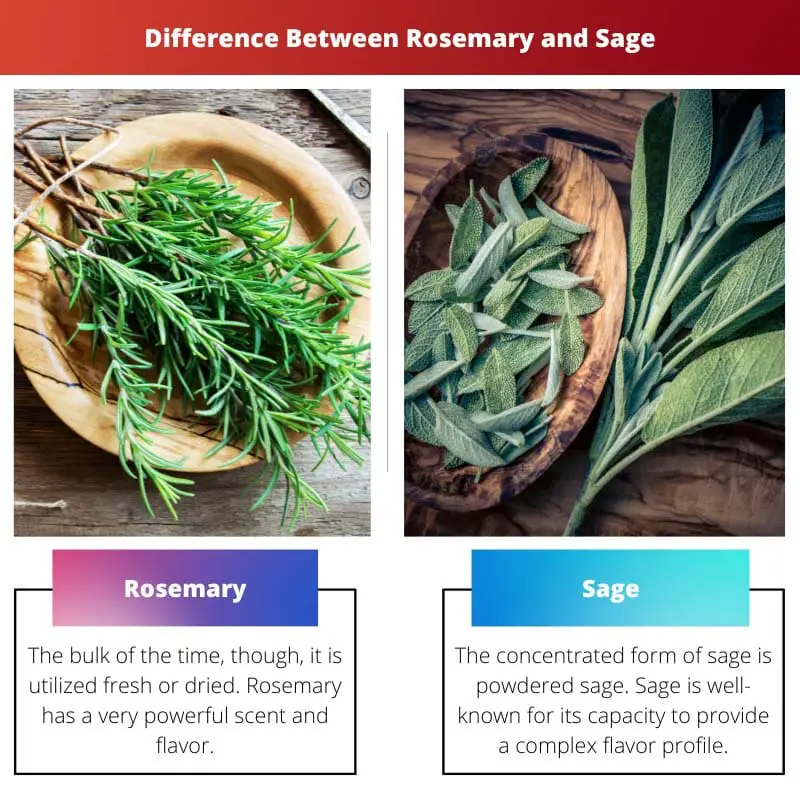Rosemary bushes are included in the chrysanthemum subclass. Rosemary has a more pronounced physical appearance than Sage. Its blossoming season, on the other hand, is much shorter.
Sage is a fragrant plant that belongs to the petal flower group. The sage plant is smaller than the rosemary plant in terms of looks.
The sage plant, on the other hand, takes longer to bloom.
Key Takeaways
- Rosemary and sage are herbs used in cooking but have distinct flavors and properties.
- Rosemary has a strong pine-like flavor and is used in Mediterranean cuisine, while sage has a more savory flavor and is commonly used in stuffing and sausage.
- Rosemary is an evergreen shrub, while sage is a perennial plant.
Rosemary vs Sage
Rosemary is a pine-like flavor used in Mediterranean dishes, while sage has a more earthy flavor and is used in dishes like stuffing and sausages. Rosemary is an evergreen shrub, while sage is a perennial herb. They both are used in cooking, but with distinct differences in applications.

The bulk of the time, though, it is utilized fresh or dried. Rosemary has a very powerful scent and flavor. It has a lemon and pine flavor, as well as a hint of spice.
Rosemary bushes are part of the chrysanthemum subclass. The Rosemary plant has a more attractive appearance than the Sage plant. Its flowering time, on the other hand, is shorter.
Rosemary is a popular crop in China’s southern provinces, particularly Shandong.
The concentrated form of sage is powdered sage. Sage is well-known for its capacity to provide a complex flavor profile. However, it lacks a citrus and pine flavor.
It also has a distinct earthiness with a strong eucalyptus note. Sage belongs to the petal flower subclass, which comprises a variety of fragrant plants.
The sage plant, on the other hand, blooms later. Sage plants can be found throughout the Yangtze River’s southern reaches, excluding the basin and plateau areas in Chinese territory.
Comparison Table
| Parameters of Comparison | Rosemary | Sage |
|---|---|---|
| Subclass | Chrysanthemum | Petal flower |
| Appearance of plant | Higher | Shorter |
| Found | Shandong Province | Yangtze River |
| Powdered form | Available yet not used | Available and used |
| Flavour and aroma | Of lemon and pine | Lacks the tint of pine and lemon |
What is Rosemary?
The Rosemary plant has a more attractive physical look than the Sage plant. Its flowering time, on the other hand, is much shorter.
Rosemary is a plant that grows in the southern portion of China, in the Shandong Province, and is considered an economic crop.
The majority of the time, however, it is used in its fresh or dried form. Rosemary has a very strong and harsh scent and flavor. It has a lemon and pine flavor to it, as well as a hint of spice.
Rosemary belongs to the chrysanthemum subclass, which also includes rosemary bushes.
Rosemary is cultivated in a bush with leaves that resemble the slender needles of a pine tree. This herb is commonly obtained in two forms, dried and fresh, and can be utilized in either.
Rosemary is also available in powdered form. However, this is not utilized.

What is Sage?
Sage is a member of the petal flower subclass, which comprises a variety of fragrant plants. The sage plant is shorter than the rosemary plant in terms of physical appearance.
The sage plant, on the other hand, flowers later. Sage plants can be found in the Yangtze River’s southern reaches, omitting the basin and plateau areas of China’s land.
Sage powder is a condensed version of the herb. Sage is well-known for its capacity to produce a powerful flavor profile. Its flavor, on the other hand, is devoid of both citrus and pine notes.
It also has a distinct earthiness with a strong eucalyptus undertone.
The sage plant is a bushy perennial with pointy but soft leaves. Due to the presence of fine hairs, the leaves have a wrinkled texture and a velvety look.
The leaves of the sage plant are available in two forms: dried and entirely fresh. They’re also available as rubbed sage or as a fine powder.

Main Differences Between Rosemary and Sage
- Rosemary is grown in a bush which possesses leaves that look similar to the needles of the pine plant, which are narrow. This herb can be found in two forms but can be used in either dried or fresh form. On the other hand, the sage’s plant is very bushy, possessing pointed yet soft leaves. However, the leaves possess a wrinkled texture and a velvety appearance due to the coverage of fine hairs.
- Rosemary also exists in powdered form, but it is not used widely in this form. However, the majority of times, it is used in its fresh or dried form. On the other hand, the leaves of the sage plant can be found in its dried and whole fresh state as well. They can also be purchased as rubbed sage or in a fine powder form. The powdery form of sage is its concentrated form.
- Rosemary possesses a very aggressive and strong aroma and flavor. It possesses a tint of lemon and pine to mind, which also involves a tint of pepper. On the other hand, Sage is popular for its ability to possess a very intense profile of flavors. However, its flavor lacks a tint of both citrus and pine. Moreover, it possesses a distinctive earthiness with an intense eucalyptus edge.
- Rosemary belongs to the subclass of chrysanthemum, which includes rosemary shrubs. On the other hand, Sage belongs to the subclass of petal flowers which includes various plants possessing fragrance.
- The physical appearance of the Rosemary plant is relatively higher than the Sage plant. However, its flowering period is relatively earlier. On the other hand, the physical appearance of the sage plant is relatively shorter than the rosemary plant. However, the flowering period of the sage plant is later.
- The Rosemary plant can be found in the southern part and the Shandong Province of China, where it is regarded as an economic crop. On the other hand, the Sage plants can be found in the Southern part of the Yangtze River, excluding the basin and plateau area in the territory of China.





